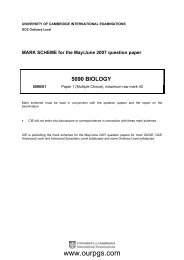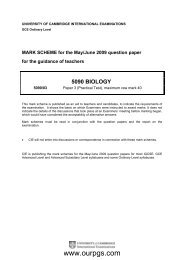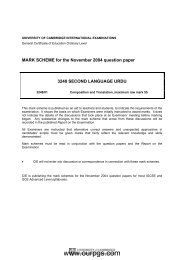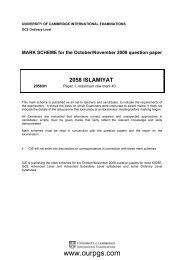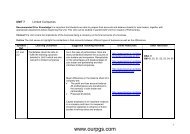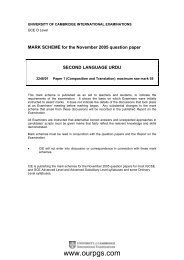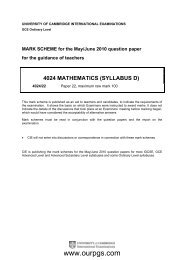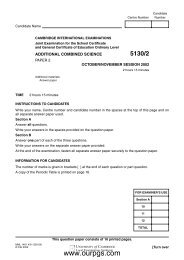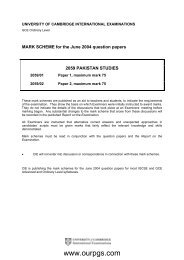Pakistan Studies-Marking Scheme/Pak.Std-MS-P1 ... - Ourpgs.com
Pakistan Studies-Marking Scheme/Pak.Std-MS-P1 ... - Ourpgs.com
Pakistan Studies-Marking Scheme/Pak.Std-MS-P1 ... - Ourpgs.com
Create successful ePaper yourself
Turn your PDF publications into a flip-book with our unique Google optimized e-Paper software.
Page 3 Mark <strong>Scheme</strong> Syllabus PaperGCE O LEVEL – October/November 2008 2059 01LEVEL 4: Explains at least two factors. English to be explained for maximum marks. [9–13]Christian missionaries came to India to convert the local population as well as setup schools. In these schools the missionaries taught Christianity and expectedlocal religions to be given up which was resented by Muslims, Hindus and Sikhsalike.The replacement of Persian and Sanskrit by English as the official language inthe 1830s deeply upset both the Muslims and Hindus. A number of social reformshad been imposed by the British without consultation or care for local feelingwhich caused much unrest. Indians had to send their children to co-educationalschools which was hated since it appeared to impose the British system on theIndians without due regard to their religious and cultural feelings. They were alsoforced to abandon purdha which had been an Indian custom for centuries. The‘Doctrine of Lapse’ caused great unrest because any local kingdom not having adirect male heir was taken over by the British. A new cartridge was introduced bythe British which was coated in both cow and pig fat. Because the soldiers had tochew the fat, this caused great resentment since pig fat was forbidden by theMuslims while the cow was a sacred animal in the eyes of the Hindus.LEVEL 5: As Level 4 – also produces a judgement or evaluation. [14]2 (a) (i) What was founded in 1885 as a result of conferences in Bombay and Calcutta?(Indian National) Congress [1](ii) Who was imprisoned in 1897 as a result of writing a newspaper article?Bal Gangadhar Tilak of Poona [1](iii) What name was given to the unsuccessful plot in which anti-British Muslimssuggested an uprising by the Muslims to free them from British rule during theFirst World War (1914-1918)?Silk Letters Conspiracy [1](iv) Where was the meeting held in 1919 that was bombed from the air?Gujranwalla (or Gujranwala) [1](b) Why did Congress oppose the Morley-Minto Reforms of 1909?LEVEL 1: Simplistic statement [1]They were against them.LEVEL 2: Identifies reasons [2–4]Because of separate electorates and lack of self rule.© UCLES 2008www.ourpgs.<strong>com</strong>
Page 4 Mark <strong>Scheme</strong> Syllabus PaperGCE O LEVEL – October/November 2008 2059 01LEVEL 3: Explains reasons [5–7]The British intended that the Indians could voice their opinions in the Councils butCongress wanted more responsibility which the government were not prepared togive. This annoyed many who were looking towards self-rule. The Britishaccepted the right of Muslims to have separate electorates which also annoyedsome Hindus who saw it as a concession too far. Some Hindus also resented therelative high position of Muslims in the Councils despite their much smallernumbers.(c) ‘The Khilafat Movement failed by 1924 because of poor leadership.’Do you agree? Give reasons for your answer.LEVEL 1: Simplistic statement [1–2]It was because of poor leadership.LEVEL 2: Description of Movement/poor leadership or other factors [3–6]Gandhi withdrew his support and because of the Chaura Chari incident.LEVEL 3: Explains at least one factor [7–10]LEVEL 4: Explains at least two factors, poor leadership to be explained for maximum marks.[9–13]Some of the leaders including Maulana Muhammad Ali were imprisoned in 1921which made the organisation less effective. Also by joining with Hindus, theobjectives of the Movement were made less clear since Hindus, and Ghandiespecially, were seen as using it for their own ends and, it was thought, didn’thave the interests of Muslims at heart.Gandhi decided that the Swaraj Movement was be<strong>com</strong>ing too violent followingthe Chaura Chari incident and so called off his support. In 1920 the Muslimmigration (hijrat) to Afghanistan took place. The Muslim League opposed this asthey wanted people to stay and fight for their cause. The migration was a failure.The Afghan government was hostile to the migrants who on their return foundtheir homes and jobs occupied, which dispirited the Muslims. Finally, the newTurkish government under Kemal Ataturk abolished the institution of the Caliph in1924, so ending the Movement.LEVEL 5: As Level 4 – also produces a judgement or evaluation [14]3 (a) (i) Name a Hindu fundamentalist movement that carried out military activities in thePunjab during 1924.Arya Samaj. Also allow Hidu Mahasabha. [1](ii) What did Gandhi embark upon in March 1930?Salt March [1]© UCLES 2008www.ourpgs.<strong>com</strong>
Page 6 Mark <strong>Scheme</strong> Syllabus PaperGCE O LEVEL – October/November 2008 2059 01Gandhi and Jinnah held talks about a Muslim homeland but failed to reachagreement since Jinnah wanted six provinces included in <strong><strong>Pak</strong>istan</strong> whereasGandhi only agreed to three. Nevertheless, it was an important meeting sinceGandhi had negotiated with the Muslim League on an equal footing for the firsttime. However, Cripps was not the only factor which was important in leading toeventual Partition. At the Simla Conference, the Viceroy realised that the twoparties were unable to reach agreement on anything. Although all parties agreedto the principle of the Executive Council, the sticking point was the method ofselection. Following the Conference, Lord Wavell announced new elections. Theresults demonstrated that Congress had control of the non-Muslim vote, but thatthe League had gained control of the Muslim vote. It was clear that the Leaguewas an equal player to Congress and that the demand for Partition could nolonger be ignored by Congress or the British Government. However, it wasfollowing the announcement by Attlee that the British would leave the subcontinentby 1948, and the subsequent violence in the Punjab in March 1947,that convinced Nehru that Partition should take place. This was formalised in the3 June Plan.LEVEL 5: As Level 4 – also produces a judgement or evaluation. [14]4 (a) (i) How many princely states were told by Lord Mountbatten that they would not begranted independence?462 [1](ii) Name the Hindu ruler of Kashmir in 1947.Hari Singh [1](iii) Who became Governor-General of <strong><strong>Pak</strong>istan</strong> in September 1948 on the death of theQuaid?Khawaja Nazimuddin [1](iv) Name the organisation that presented the draft constitution to the <strong><strong>Pak</strong>istan</strong>Assembly in 1950.Basic Principles Committee [1](b) Why did East <strong><strong>Pak</strong>istan</strong> wish to be<strong>com</strong>e independent of West <strong><strong>Pak</strong>istan</strong>?LEVEL 1: Simplistic answer [1]It saw no alternative.LEVEL 2: Identifies reasons [2–4]It was a long way from West <strong><strong>Pak</strong>istan</strong> and was poorer.© UCLES 2008www.ourpgs.<strong>com</strong>
Page 7 Mark <strong>Scheme</strong> Syllabus PaperGCE O LEVEL – October/November 2008 2059 01LEVEL 3: Explains reasons [5–7]East <strong><strong>Pak</strong>istan</strong> was resentful of the fact that it was under-represented in the<strong><strong>Pak</strong>istan</strong>i army and the Civil Service. Due to the distance from the West, it feltthat it was under political repression and with an undemocratic government.Because it had a weaker industrial base than the West and suffered from floods,it resented that it received little attention from the rest of <strong><strong>Pak</strong>istan</strong>.(c) ‘Education reforms were the most important of Zulfiqar Ali Bhutto’s domestic policiesbetween 1971 and 1977.’ Do you agree? Give reasons for your answer.LEVEL 1: Simplistic statement [1–2]Schools were built.LEVEL 2: Description of education reforms or other domestic policies [3–6]He introduced free primary education and rural health centres.LEVEL 3: Explains at least one factor [7–10]LEVEL 4: Explains at least two. Education reforms to be explained for maximum marks[9–13]Amongst Bhutto’s education reforms, free primary education was introduced.New schools were to be built and all private sector schools were nationalised.The aim was to increase the literacy rate and raise academic standards. Thechanges in education led to overcrowding in existing schools whist new onescould be built. The reforms were not very successful since the building of newschools and the recruitment of new teachers could not be achieved quickly andwas also very expensive. Many families resented the educational reforms since itmeant a loss of earnings to them.However other aspects of his domestic policies were also important. He alsotried to improve the infant mortality and age expectancy rates by introducingRural Health Centres and Basic Health Units. Pharmaceutical <strong>com</strong>panies werebanned from charging for a particular medical brand name and so medicinesbecame cheaper. However this did see the profits of chemists fall drastically andmany international drug <strong>com</strong>panies closed down their operations in <strong><strong>Pak</strong>istan</strong>.A new constitution drawn up in 1973 established a senate which offered theopportunity for professionals, academics and specialists to work together. It alsosafeguarded the interests of minority provinces which now had an equal status inthe Senate. He produced the 1973 Constitution in an attempt to return to a formof parliamentary democracy and it was important since it is the basis upon which<strong><strong>Pak</strong>istan</strong> has been governed to the end of the 20th Century (apart from when itwas suspended due to martial law). One of the main weaknesses of the newconstitution was that the focal point of political power lay with the partyleadership, and Bhutto in particular. When things went wrong, the blame wasclearly laid at his feet.LEVEL 5: As Level 4 – also produces a judgement or evaluation. [14]© UCLES 2008www.ourpgs.<strong>com</strong>
Page 8 Mark <strong>Scheme</strong> Syllabus PaperGCE O LEVEL – October/November 2008 2059 015 (a) (i) Who was dismissed as Prime Minister by Iskander Mirza in 1955?Ali Bogra [1](ii) Who did Ayub Khan appoint as the Rehabilitation Minister during the ‘Decade ofDevelopment’?General Azam Khan [1](iii) What law did Zia ul-Haq introduce to establish military courts to try offendersaccording to martial law in 1979?Constitution (Amendment) Act [1](iv) Who became acting President of <strong><strong>Pak</strong>istan</strong> on the death of Zia ul-Haq in 1988?Ghulam Ishaq Khan [1](b) Why did <strong><strong>Pak</strong>istan</strong> support the Palestinian cause between 1947 and 1988?LEVEL 1: Simplistic answer [1]It felt that it was important to <strong><strong>Pak</strong>istan</strong>.LEVEL 2: Identifies reasons [2–4]They are Muslims and because of the fire in the Al-Aqsa Mosque.LEVEL 3: Explains reasons [5–7]<strong><strong>Pak</strong>istan</strong>is identify themselves with the Palestinians as fellow Muslims whoshould be supported in their Cause. The objective of the OIC, of which <strong><strong>Pak</strong>istan</strong>is a member, is to promote harmony and co-operation between Muslim nations.The incident of the Al-Aqsa Mosque was discussed at the first meeting of the OICand support offered to the Palestinians. At the Second Conference in 1974, morespecific support was forth<strong>com</strong>ing.(c) How successful was <strong><strong>Pak</strong>istan</strong> in its relationship with India between 1947 and 1988?LEVEL 1: Simplistic statement [1–2]Relations between the two nations have been very poor.LEVEL 2: Description of relationship [3–6]Outlines the Kashmir Crisis and the Wars in 1965 and 1971; nuclear tests in1974.LEVEL 3: Explains the successes OR failures [7–10]© UCLES 2008www.ourpgs.<strong>com</strong>
Page 9 Mark <strong>Scheme</strong> Syllabus PaperGCE O LEVEL – October/November 2008 2059 01LEVEL 4: Explains the successes AND failures [9–13]SuccessesAgreement regarding border between East Bengal and Assam 1948Minorities Agreement 1950Simla Accord 1972FailuresKashmir1965 and 1971 WarsNuclear arms raceAftermath of Indira Gandhi’s assassinationLEVEL 5: As Level 4 – also produces a judgement or evaluation. [14]© UCLES 2008www.ourpgs.<strong>com</strong>



